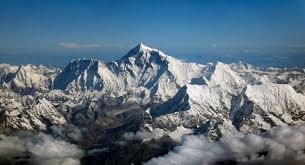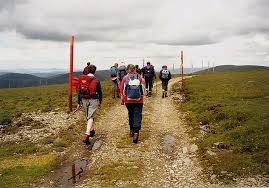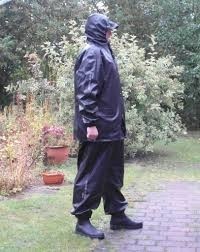Waterproof clothing.
This was my original article on performance outdoor waterproofs. It hasn't aged too badly but there have obviously been a couple of changes since 2007. The new version is also published on BeBee.com. https://www.bebee.com/producer/@neil-smith/waterproof-and-breathable-outdoor-clothing

Until the late nineteen seventies waterproof rainwear used in the outdoors consisted of nylon fabric coated plentifully with a layer of either polyurethane or neoprene on the inside. Jackets and trousers were heavy, stiff and noisy as well as impermeable
.
Such garments were usually quite good at keeping the rain out and equally good at keeping the sweat in. The result was that the mountain walker got wet from one source or other no matter what. Gear articles in magazines and books such as the Spur book of walking gave advice based on the idea that it was safer to be wet and warm rather than wet and cold so keep your waterproofs on.
The walker caught in a series of showers had to make a judgement call as to whether it was rainy enough to make it worth getting suited up in raingear or just to continue, hoping that the shower would pass and that one would dry off in due course. It was not uncommon to pass groups of people where different choices had been made and note that some were drenched in breeches and woolly shirts whilst others were drenched in sweat inside a nylon bin liner with sleeves.
Some days there was just no right answer.
In 1978 a new fabric appeared and nothing would ever be the same again.
W. L. Gore and Co. introduced a new material called Gore-Tex. This was light, soft, flexible and ...BREATHABLE. Suddenly perspiration could escape from the inside of the jacket and somehow, magically get through the fabric of the garment. The concept behind this new laminated wonder fabric was that it would be comfortable rainwear that we could wear between showers and not feel like we were trying to make the weight for a middleweight boxing match.
According to some of the early claims we would wear this stuff all day in perfect climate controlled bliss and the nasty weather was something that happened outside that didn't need to concern us.
Back on Earth there were a few problems with the early editions of the fabric. It was prone to delaminating so that the layers of fabric would separate and leak. The durability was hugely inferior to the old neoprene coated cagoules and the much vaunted breathability was not quite as similar to a running vest as some people had convinced themselves it would be. At an unscientific estimate however it was about a trillion times more comfortable than anything else on the market and there was to be no going back.
In no time at all every outdoor clothing manufacturer had a range of breathable rainwear and soon that's all there was.
As the years went by technology, design and manufacturing expertise improved at an incredible rate and looking at a nineteen seventies raincoat alongside a modern equivalent is a bit like staring back to a long lost time. Truly that was the age of the steam powered jacket.

Buying a waterproof jacket.
As with everything outdoor the first thing is to decide what you want the jacket for. The obvious answer is "For when it's raining" but beyond the obvious, jackets are constructed from different materials and with different features depending on the requirements of the end user so we will take a look at some broad categories. Bear in mind that few people do one thing only. Many climbers do a bit of running; some hillwalkers indulge in a spot of sailing and so on. This means that a degree of compromise may be necessary in some areas but should not mean that a jacket works in one arena but is utterly hopeless in another. Modern gear is far too good for this ever to be the case.

Expedition/summit jackets.
In answer to the question “who’s the daddy?” the correct answer is that these jackets are. By its nature expedition outerwear is designed to cope with the fiercest of weather at all altitudes and latitudes. For anyone planning an Arctic traverse or a trek into Cho Oyu this is the level of clothing that comes as standard.
Featuring a top class breathable waterproof fabric, pockets are kept high so they do not interfere with a harness and the hood would be large enough to comfortably contain a climbing helmet. Some might feature venting zips or pockets but the emphasis is on freedom of movement, light weight and foul-weather performance so you don’t see a lot of gimmicks built into these jackets. Someone crossing Greenland tends not to look for a jacket with a cool iPod pouch.
Weight of fabric varies a bit between designs. Some believe that these should be made from heavy abrasion resistant fabric whilst others go for a lighter fabric with better movement and greater comfort. With new fabrics getting better all the time this has almost become an irrelevance as the newest iterations of waterproof materials combine light weight with excellent strength and durability.
Do you need one of these if you are not operating on the extremes? Frankly, no. For someone who does an occasional bit of walking around Germany’s Black Forest this is more indulgence than necessity. Not to say it won’t work extremely well but it would certainly be just a bit more expensive than strictly required. If you regularly find yourself topping out on Ben Nevis in January amidst swirling snow, with the wind howling, and it could be several hours before getting to shelter then the expense is much more easily justified. The choice as ever, is yours to make.
Hillwalking.
The biggest general category with the most choice and greatest variation in features, prices, fabrics and performance.
This is the Ford Focus to the previous category’s Hummer. The fundamental difference between jackets in this area is Fabric. A jacket made from an expensive, branded, performance fabric will be more expensive than one cut from a generic waterproof, breathable fabric. Over the years some manufacturers have produced near identical versions of garments in two fabric options and left it up to the customers to decide what level of performance they are willing to pay for.
All fabrics used by the quality manufacturers will keep the rain off. Some for a few years longer or under greater pressure. The biggest difference is in the area of breathability and comfort. Better fabrics let more perspiration out of the jacket faster. Softer fabrics drape better around the body and fit more closely allowing more natural movement. Some jackets are very lightweight and can be packed away into an extremely small space. If you are interested in multi day backpacking and keeping the weight on your back as low as possible this would be a very attractive feature. Perhaps however you frequently go walking in a densely vegetated area with a lot of thorny juniper bushes. You might in this case shy away from super thin and light in favour of a jacket made from a somewhat thicker, harder to pierce fabric. Someone who sweats more profusely might prefer the ultimate in breathability whilst a person in fierce winter conditions could be happier in a bigger, chunkier jacket. The options are almost as endless as they seem.
When choosing a hillwalking jacket, try to form an idea of what you are looking for in the way of features. A map pocket is usually handy an MP3 pocket is only sometimes handy. If you don't want to take your tunes with you then don't pay for that feature. Establish your budget and what fabric and features you want to spend it on. Just remember you don't get too many gold bricks for a fiver. The dearer jackets are generally the better jackets. They get better fabric, better cut and have more features. That's the reason they are dearer. Pick three or four of a shortlist and try them on. Are they a comfortable fit? Swing your arms, can you move them freely? How do they feel with a rucksack on? Do the rucksack straps get in the way of the pockets or drawcords? If you do not have your pack with you then borrow a loaded one from the store to try out. At this point you should find one to be more comfortable or a better fit than the others if however you don’t and two or more all seem fine then feel free to make the choice on aesthetic grounds or the toss of a coin. All the major manufacturers make very high quality products and if you were choosing from four equivalents it would be pretty much impossible to make a poor choice.

General purpose.
Waterproofs for every single rainy day no matter where you may be or what you may be doing.
You may not have a mountain specific jacket that only gets worn when you have your boots on above fifteen hundred feet. Those of us in Ireland live in a place with a more than adequate share of precipitation throughout the year including those days when we have to go to work, walk the dog, watch the kids from the side of a sports pitch or just nip out to the shops. These jackets are slightly de-tuned mountain jackets. They are as likely to be seen on the high street. as the hillside. Made from the same fabrics as their higher spec cousins these will generally feature lighter hoods which are rolled away or removed completely. A less precise fit and pockets which are lower down as they don’t need to keep out of the way of harnesses and hip belts.
This style suits someone who does a fair bit of hillwalking but is not tramping around the hills every week. They do however spend quite a lot of time out of doors and have no intention of being regularly soaked.
At the lower end of the price scale these can be pretty basic pacamac style garments which fit where they touch while at the upper end the higher quality models make a serious overlap into territory staked out by Hillwalking jackets.
As before ask yourself what you really want it to do and how much you want to spend. Reflective patches would be a handy safety feature for someone who lives along a dark country road. A zip-in fleece liner might be a convenient way to create a much warmer jacket for the winter months and a soft material around the chin makes the neck more comfortable when you are hunched inside on a miserable day. All of these features are desirable to someone and available from most manufacturers for a price. The more you want the greater the cost. Just don't pay for something that you don't really need or want.
Dynamic.
These are super lightweight jackets for people who are planning to work up a sweat. Cut above the hips the short style allows maximum freedom of movement and minimal weight for runners, cyclists and orienteers amongst many others. If there is a hood at all it is a light, roll away one stuffed into the collar. Pockets are small. Big enough to contain the car keys and an energy bar but not much else. Extreme weather protection is definitely compromised to achieve a lighter more packable design so these are often only seen on higher slopes during mountain marathons or other endurance events. Suitable for people who are obsessive enough about the weight they carry to cut the handle off their toothbrush and trim their bootlaces. Anyone purchasing one of these should be aware of the limitations but they give a good level of protection in a featherweight package that is small enough to fit in your pocket. Excellent when used appropriately.
Waterproof trousers.
Everything that has been written here applies equally to rainpants. Breathability, water resistance, fit and freedom of movement all improve as you move up through the price bands but there are a couple of extra points to bear in mind.
Trousers generally take more of a beating during normal use than jackets and consequently wear out faster. Stress on vulnerable areas such as the knees or backside means that leakage can occur sooner. This is especially true of rainpants used for cycling. Constant flexing at the knee and pressure on the saddle means that it is not uncommon for cyclists to get through an extra pair of pants for each jacket. For this reason some cyclists opt for a cheaper, more basic pair of rain trousers to match a higher quality jacket. This is not in any way a problem; just don’t be surprised when the performance fails to match top and bottom.
Ice climbers and glacier travellers who regularly use crampons (sometimes carelessly) also may decide to go for a more basic lower half if they are going to be slicing through their rainpants with their freshly sharpened front points. Some have a “good“ set of high performance rainpants for non crampon excursions and a cheaper, older, more basic pair for winter ascents on technical routes.
The biggest feature difference between pants is in the area of side zips. Some are just made baggy below the knee so that you can get them on over hiking boots. This is simple and effective but tends to produce a fairly seventies look and leaves a lot of material flapping about. The most common system is a gusseted half zip running up to the knee. This lets you expand the lower leg area to allow booted access and then zips up again to keep everything nice and neat and less likely to get caught on barbed wire or thorns. The other option is a full length zip running all the way up the leg. This allows the wearer to put the rainpants on without removing mountaineering boots, crampons even skis. This is more expensive to do so is most often included on high end mountaineering garments. Potentially there is a greater risk of water ingress through the zip but in practice this has not been a problem.

Durable, Water repellent coatings (DWR).
A waterproof garment is a nylon or polyester shell. On the inside of the shell is a layer of waterproof “stuff”. This may be a thin sheet of a substance laminated between two layers of fabric or a coating which is bonded to the inside of the shell by any one of a number of methods but however it is attached or whatever its nature this is the bit that keeps you dry. If you doubt this take a nylon bed sheet out in the rain, wrap it around yourself and see how long you stay dry.
The nylon outer material is not remotely waterproof on its own and left untreated would soak up moisture on its outer surface which would leave the inside of the garment colder, clammy, not at all breathable and much less comfortable to wear.
Applying a water repellent layer, the DWR, to the outer face of the material prevents this from happening. The DWR coating prevents water from soaking into the nylon fibres causing it to run off. The fabric then stays drier allowing perspiration to pass out through the material more easily. This keeps the wearer drier, warmer and more comfortable.
Over time this DWR layer gets worn or covered in dirt and grime becoming less effective. Once this happens people often think that their garment has started to leak as they notice more damp patches on the inside and feel colder. The solution is to keep the garment clean with regular washing using the correct soap and to top up the DWR layer every so often with a specific proofer.
All waterproof shell garments are designed to be machine washable on a gentle cycle at a low temperature. Just follow the manufacturer’s instructions.
A dirty, soiled jacket is not just smelly and aesthetically displeasing it is seriously reduced in performance.
Realistically you don’t wash your shirts every three years or your socks annually. Why should your waterproof rainwear be any different?
Notes on defining “Waterproof”.
Once upon a time a jacket came back to an outdoor store from a maker of quality outdoor rainwear. A customer had returned the jacket complaining of leakage around the chest area and after a series of tests the company were pretty sure what the source of the problem was. After a short phone call and a couple of questions the verdict was communicated by mail. The letter read “Customer should put up hood.”.
However good the fabric or design there will always be a great big hole at the top of a jacket for your head to stick out. If the hood is not used and tightened fully then water will get in this hole. Admittedly hoods can be pretty claustrophobic but if you choose not to use it then expect some internal dampness.
The resistance to water penetration is expressed with reference to the “Hydrostatic head” of the fabric. This refers to a tall column of water rising from the stretched fabric. The taller the column the greater the pressure of water building up on the fabric. A fabric which can resist water penetration from a 3500mm column is officially classed as being waterproof as are fabrics resisting to a greater or lesser degree. What makes a fabric with a 6000mm hydrostatic head more desirable is its ability to withstand water penetration at greater pressures for example when crawling on hands and knees into a tent where pressure on the knee sections is greatly increased.
A bigger number is not the whole story though and a huge part of the durability of a garment is down to the design and quality of manufacture.
Notes on Breathable.
There is no such thing as a garment which is absolutely 100% breathable. Humans generate an increasing amount of perspiration as their activity rate rises. Put in more effort and you will sweat more. Assuming that your clothing is temperature neutral i.e. not a thick insulating layer then what you wear will hardly affect how much you sweat. What your clothing will do is manage the dissipation of that sweat and move it away from your body to maintain a dry micro climate next to your skin. Boxers training in a gym whilst wearing a bin liner are not sweating any more than in they wore a running vest, they just feel the moisture more because it has nowhere to go and sits on the skin making for a very clammy feeling. The same boxer training outdoors in a wicking top will feel much more comfortable and less soggy but crucially will be losing just as much fluid through perspiration. Just because you don't notice it doesn't mean you are not perspiring.
In the context of a waterproof jacket a top class ultra thin fabric will transport more moisture away from the body than a cheaper, thicker fabric but even the best of fabrics will struggle to keep up when the exertion level rises. For instance on a flat trail at a moderate pace any particular jacket will cope well. Speed up a bit and some will have problems coping and so you will feel a slight build up of moisture within the jacket. Go up a steep incline at the same fast pace and pretty much every jacket will suffer to some degree with moisture accumulation.
Other factors which affect the breathability we have touched on already. If your garment is soiled or the DWR is worn then breathability drops rapidly and the wearer will feel colder and clammier. Wearing the correct base and mid-layers is also essential. Cotton fibres absorb and retain moisture, preventing it from reaching the jacket and so maintaining a damp climate close to the body so try to avoid cotton t-shirts or jerseys.
Remember to use the zips to vent your jacket and let air in. Many have pit zips or vented pockets but even if this is not the case it is usually possible to adjust the main zip and loosen the drawcord around the waist to encourage a better flow of air and keep you drier and more comfortable.
Ultimately if you don't expect magic you won't be disappointed.
"""""Articles from Neil Smith
View blog
There are occasional moments when I step back and wonder if perhaps, I am not entirely the mature, b ...

I was thinking about some friends the other day. · Real friends, from real life, that I really have. ...

Music has been many things. An escape, a motivation and an inspiration. An aural journey that starte ...
You may be interested in these jobs
-
Fund Services Manager
Found in: beBee S2 IE - 23 hours ago
Alter Domus Dublin, IrelandABOUT US · We are Alter Domus. Meaning "The Other House" in Latin, Alter Domus is proud to be home to 85% of the top 30 asset managers in the alternatives industry, and more than 5,000 professionals across 23 countries. · With a deep understanding of what it takes to succeed in ...
-

Online Agile, Manual Testing, Azure DevOps, Environment tutor
Found in: beBee S2 IE - 3 days ago
TeacherOn Dublin, Ireland Part timeI am looking to help in my new assignment. Looking for Mentor to help to complete my assignments on time. Looking some one with Agile environment experience on Manual Testing. Creating Task, and execution in Azure Devops work flow. Possible Public schemes project expert. · Level: ...
-
Key Account Manager
Found in: beBee S2 IE - 1 week ago
Cpl Dublin, Ireland Full timeMy client is a major global visual content creator and marketplace. · What we are looking for? · You are a dedicated sales professional who is well organised, self-motivated and has a consistent track record of success in delivering against targets. As an excellent communicator, ...


Comments